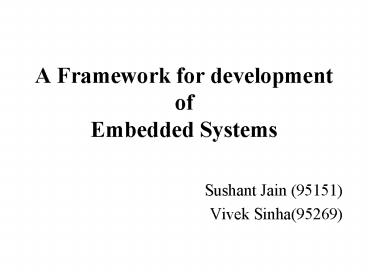A Framework for development of Embedded Systems - PowerPoint PPT Presentation
1 / 22
Title:
A Framework for development of Embedded Systems
Description:
Chinook. Co-Simulation. Ptolemy. TSS. Specification Standards. MPI 1.1. Pthreads ... Polis, Ptolemy, Chinook, COSYMA. Installation and working with COSYMA ... – PowerPoint PPT presentation
Number of Views:63
Avg rating:3.0/5.0
Title: A Framework for development of Embedded Systems
1
A Framework for development ofEmbedded Systems
- Sushant Jain (95151)
- Vivek Sinha(95269)
2
Objectives and Scope
- Automation of design process of real time
embedded systems - Evaluation of existing public domain frame works
3
Evaluation of Tools for Embedded Systems
- HW-SW Co-Design Frameworks
- POLIS
- COSYMA
- Chinook
- Co-Simulation
- Ptolemy
- TSS
- Specification Standards
- MPI 1.1
- Pthreads
4
Conclusions of Survey
- Existing tools are not suitable for compute
intensive applications and complex applications
like tracking etc ... - Working with COSYMA
- Does not works for parallel processes
- Its implementation is not stable enough for our
project and severely limits the scope of the
project - A New Methodology is needed
5
Proposed Design Methodology
- SUIF as the internal representation
- Very well defined
- Extensible Annotations
- C can be used as a specification language
- Clean path to software
- Usable and Robust
- Used for many external research projects
- Good Support Itself an active research project
6
Outline of the New Methodology
- Specification
- Architecture Template
- Partitioning
- Synthesis
- Software synthesis SUIF -gt C
- Hardware synthesis SUIF -gt VHDL
- Co-Simulation
- Ptolemy
7
Architecture Template
8
Partitioning
- Granularity of Partitioning
- Process level
- Function level
- Thread level
- Instruction level
9
Specification
- Specification is in C
- Models of parallelism supported
- Parallel processes communicating through
message passing (MPI 1.1) - Multiple threads can be defined in a process
which communicate through shared memory
(Pthreads) - Tailoring the existing standards for our project
- Subsets of MPI
- Subsets of Pthreads
10
Real Time Constraint Specification
- Rate constraint
- latency constraint
- timeout
- intraprocess constraint
11
Style restrictions due to MPI notion of processes
- No of processes should be known at compile time
- A procedure should be defined for each process
which defines the body of the process - MPI blocking communication functions should not
be called inside a condition or a loop - Similar restrictions are on pthread_create
function and other blocking calls.
12
(No Transcript)
13
Development of ESIR
14
Annotation Definitions
- Annotations structure at present defined and
implemented are - top level annotation
- process
- functions
- if node
- for node
- mpi functions
- pthread functions
15
Annotations in SUIF
- Basics
- Flat annotations
- Structured Annotations
- Restrictions in Structured Annotations
16
ESIR annotations as Classes
17
SUIF passes
- Identification of processes and creating
communication graph - Adding annotations to for nodes and if nodes
- A pass which displays the existing annotations
attached
18
Case Studies
- Image Tracking application using
- Pthreads
- MPI
- Distributed matrix multiplication program
19
Matrix Multiplication
- Distributive implementation using client server
model - All clients share same code
- Small changes required to convert the original
application into the format required by new
framework - The issue of sharing of functions between
processes arises
20
Conclusions and Results of case studies
- An application spread over multiple files can be
handled - External libraries can be used in application
- Communication graph whenever possible was built
appropriately - ESIR annotations were correctly written out and
can be used by subsequent passes
21
Summary of Contributions
- Evaluation of Public Domain Tools
- Polis, Ptolemy, Chinook, COSYMA
- Installation and working with COSYMA
- Proposal of new design methodology
- Exploring models of parallelism for new
methodology - Detailed study and working with MPI-1.1
- Selection of subsets of MPI and Pthreads
- Development of ESIR
- Identifying information required as annotations
- Defining and implementing annotation data
structures - Writing and testing of SUIF passes on case
studies
22
Future Work
- Specification
- ESIR Development
- Tool Development and integration with ESIR































